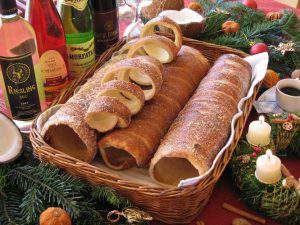Recipe of the week: Chimney cake
In the Hungarian speech area, the chimney cake (kürtős kalács) is a Szekler, Transylvanian and Hungarian dessert at the same time. Its origin has been the topic of arguments for many years, several legends can be connected to its story. Chimney cakes are characterised by an unmatched smell and aroma, and divinely sweet flavours. If you’d like to learn how to make it, you’re in the good place 😉
Vitezkurtos.hu writes that the chimney cake is mostly referred to as a Transylvanian specialty, as the national dish of Szeklerland, which used to be made at the time of weddings, religious festivities, christenings and other events. The tradition is still alive, although the consumption of the dessert is connected to certain occasions any more.

Photo: Wiki Commons By International Kürtősh Kalách Trade Corporation
One of the main arguments around the chimney cake is about its Hungarian name. Some people pronounce it as kürtös kalács, while others say kürtőskalács. The first group traces back the origin of the dessert to the time of the Hungarian conquest. It is believed that when the incursive Hungarians sacked some flour and eggs, they made a dough, rolled it on their horns (kürt) and baked it over fire. However, others doubt that the chimney cake has anything to do with the Hungarian conquest, because the method necessitates a more developed cuisine.
According to the other theory, the chimney cake was named after the stovepipe, because it is called kürtőcső in Szeklerland. The resourceful Szeklers wanted to reuse the ember of the hardwood used for cooking and heating, so they put the burning ember on top of the stove or in front of the furnace, and baked the chimney cake.
There are many myths about the origin of the chimney cake. One of the most popular ones is connected to the Mongol invasion. It is believed that the population of Szeklerland decided to escape from the Tatar troops. Some people went up to the hills, while others hid in the caves of Budvár and Rez. Since the Tatars couldn’t attack or approach them, they decided to starve the Szeklers out. This went on for a long time, until both the Tatars and Szeklers lived up their food. But a smart Szekler woman scraped together the leftover flour, mixed it with ash and baked huge loafs, which they put on wooden dongs or tall poles and showed to the Tatars: “Look, how great we’re doing while you’re starving!” The Tatars gave up and marched off resentfully.

Photo: www.facebook.com/VitézKürtős
This is why the chimney cake is also called a dong doughnut (dorongfánk). The long and short of it is that there are many stories, but one thing is for sure: the whole world loves these characteristic and delicious treats that you have to try at least once in your life. Here is a recipe if you’d like to impress your guests with a unique dessert choice.
Ingredients (for 10):
- 1 kg of flour
- 300 grams of butter
- 100 grams of powdered sugar
- 40 grams of yeast
- 2 eggs
- 2 egg yolks
- 5 dl of milk
- possible toppings: caster sugar, cinnamon, vanilla sugar, ground walnut, coconut flakes etc.

Photo: Wiki Commons By Vszhuba
Directions:
Let the yeast rise in 1 dl lukewarm milk, and mix it with the flour, soft butter, powdered sugar, eggs and egg yolks. Add the remaining milk and knead the dough for 10-15 minutes. Let it sit in a warm place for an hour.
After the dough has doubled in size, roll it out and cut 1.5 centimetre wide strips. Wrap the strips around the buttered wooden dongs in a way that one layer slightly overlaps the next layer. Roll the dongs on the table so that the dough will be evenly spread. Then, roll the dough into the cinnamon sugar mixture (or whatever topping you chose to go for).
Some supermarkets carry wooden dongs, but if you can’t seem to find any, wrap a smaller rolling pin with aluminium foil, brush it with butter and continue as if it was your homemade dong.
Place the wooden dong on a baking tin and bake your chimney cakes at 170-180° Celsius. Make sure to turn it two or three times until the sugar melts on the outside.

Photo: Wiki Commons By Alpha
Enjoy the dessert!
Provide your audience with essential culinary tips and video tutorials by streaming live videos into the cloud with windows virtual desktop with remote access to your windows applications and data from CloudDesktopOnline.com powered by one of the best DaaS providers – Apps4Rent.
Featured image: www.facebook.com/VitézKürtős
Ce: bm
Source: Daily News Hungary
please make a donation here
Hot news
Top Hungary news: train derailed, huge tax against short-term rentals, new train stations, Hungarians about the war, Dracula, cocktail bars — 21 October, 2024
Hungarian research could yield breakthrough in Covid-19 treatment
5+1 stylish cocktail bars in Budapest to explore with your friends after a long day
Railway stations in major Hungarian cities to be completely rebuilt with private capital
Young people planning armed attacks against protected persons in Hungary – US intelligence warns
Hungary, Laos agriculture ties strengthening: Minister Linkham Duangsavanh visits Budapest






2 Comments
Might want to change “dong” to “spit” in this as “dong” does not mean that. It is a slang term for the male organ and does not appear in English dictionaries with this meaning. Yes, the Sztaki online dictionary translates it this way, but Sztaki is wrong.
[…] Kürtös Kalács, or chimney cake, is another quintessential Hungarian street snack. It’s a long, spiral raised pastry that is filled with cream or other sweet toppings. It’s best purchased fresh at a market, but here’s a recipe if you want to try it out at home! […]